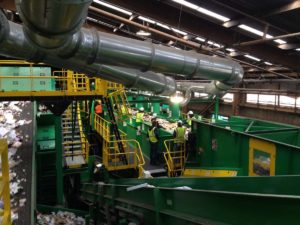 It is my belief that we have significant opportunities to improve both the quantity and quality of recycled materials. To help the industry take action and ensure our materials are actually used as feedstock by manufacturers, we can focus on four distinct areas.
It is my belief that we have significant opportunities to improve both the quantity and quality of recycled materials. To help the industry take action and ensure our materials are actually used as feedstock by manufacturers, we can focus on four distinct areas.


 Current market conditions have led to very difficult times for many in the recycling industry. The substitution of recycled content for virgin material universally saves energy in the manufacturing process. Therefore, when energy prices are depressed, recycling’s value declines. The current strength of the dollar exacerbates the downward pressure on our commonly collected commodities. The outlook for the next few years does not present a promising picture.
Current market conditions have led to very difficult times for many in the recycling industry. The substitution of recycled content for virgin material universally saves energy in the manufacturing process. Therefore, when energy prices are depressed, recycling’s value declines. The current strength of the dollar exacerbates the downward pressure on our commonly collected commodities. The outlook for the next few years does not present a promising picture. A startup is using robotics, artificial intelligence and the cloud to combat recycling contamination at one of its sources: public collection bins.
A startup is using robotics, artificial intelligence and the cloud to combat recycling contamination at one of its sources: public collection bins. When it comes to materials processing contracts, the debate is often framed in black and white: taxpayers versus shareholders battling to collect the financial rewards of recycling and avoid the costs.
When it comes to materials processing contracts, the debate is often framed in black and white: taxpayers versus shareholders battling to collect the financial rewards of recycling and avoid the costs. How can recycling programs across the country efficiently recover glass and overcome challenges in the value chain? Several stakeholders delved into the issue at the Resource Recycling Conference.
How can recycling programs across the country efficiently recover glass and overcome challenges in the value chain? Several stakeholders delved into the issue at the Resource Recycling Conference. Massachusetts provides seven grants to recycling businesses to help boost volumes and quality, and North Carolina accepts applications for its own business development grant program.
Massachusetts provides seven grants to recycling businesses to help boost volumes and quality, and North Carolina accepts applications for its own business development grant program. The closing of container-redemption centers across California has meant dirtier downstream loads of recovered glass. Regulators are now adding emergency regulations to ensure that increased contamination doesn’t threaten the state’s glass recycling industry.
The closing of container-redemption centers across California has meant dirtier downstream loads of recovered glass. Regulators are now adding emergency regulations to ensure that increased contamination doesn’t threaten the state’s glass recycling industry.
 An Associated Recyclers of Wisconsin task force has released a report with recommendations on how to operate a successful glass recycling program within the state.
An Associated Recyclers of Wisconsin task force has released a report with recommendations on how to operate a successful glass recycling program within the state.